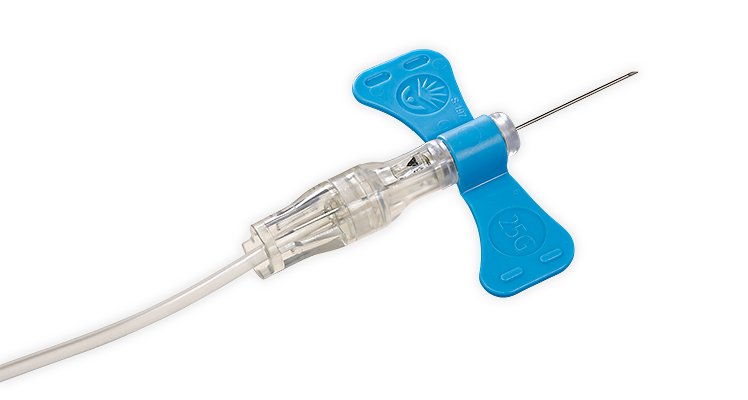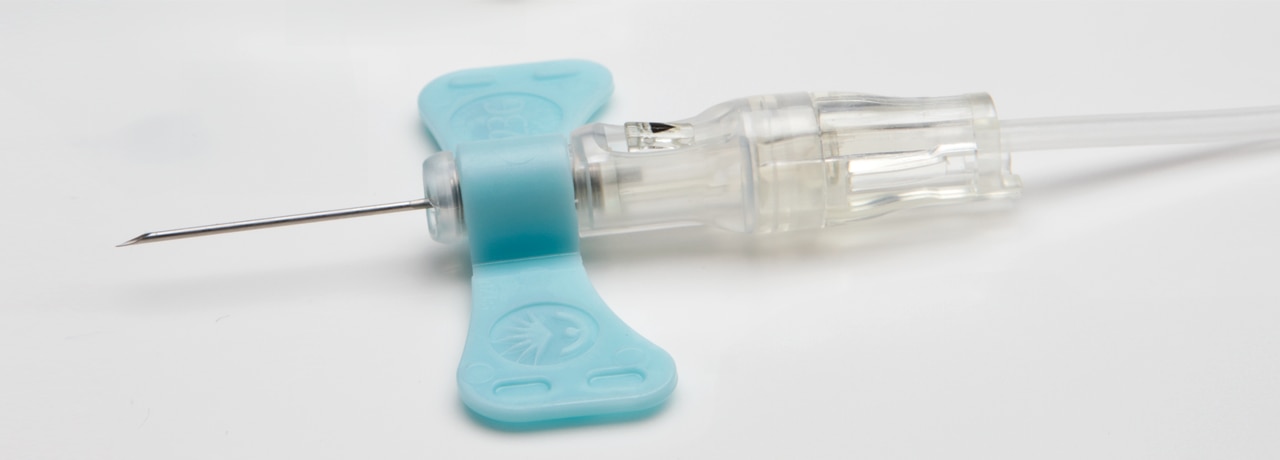Designed to deliver a positive patient experience

test the section name text
test the section description text

BD PentaPoint™ 5-bevel needle design significantly reduces penetration forces compared to a 3-bevel design of the same gauge4
BD RightGauge™ ultra-thin wall cannula enables use of a smaller needle for blood collection in all patients including those with difficult venous access7
BD RightGauge™ ultra-thin wall cannula creates a larger inner diameter than traditional thin wall cannula of the same gauge, which results in faster tube fill time5
BD PushButton technology enables single-handed, in-vein needle retraction aids in the prevention of accidental needlestick injury7
Flashback visualization indicates vein entry for confidence during blood collection7
The phlebotomy procedure is often one of the patient’s first encounters upon entering the hospital and may be a source of pain, stress and anxiety. For the majority of patients, it sets the tone for their entire journey and influences their overall satisfaction.1,8
The BD Vacutainer® UltraTouch™ push button blood collection set helps you offer your patients a more comfortable and positive phlebotomy experience.1-5
The unique BD RightGauge™ ultra-thin wall cannula technology creates a larger inner diameter than wingsets with thin wall cannula, allowing the use of a smaller gauge needle for blood collection in all patients including those with difficult venous access — who commonly have small, fragile and/or non-palpable veins, such as pediatric, oncology and geriatric patient populations — without creating sample quality issues typically associated with smaller gauges. By using a smaller gauge needle, you can improve the overall phlebotomy experience for your patients. Patients report significantly less overall pain* when the 25G BD Vacutainer® UltraTouch™ push button blood collection set is used compared with a traditional 23G wingset, with no impact in tube-filling times and hemolysis rate.1,2,6,7
In addition, the BD Vacutainer® UltraTouch™ push button blood collection set with BD RightGauge™ ultra-thin wall cannula technology was shown to reduce tube fill times by up to 50% compared to a traditional thin-wall cannula of the same gauge†, which can help you improve the overall patient blood collection experience.5
Needlestick injuries are a severe threat, potentially exposing healthcare workers to more than 20 bloodborne infections with serious diseases, such as HIV, HCV and HBV. An estimated 385,000 needlestick injuries and other sharps-related injuries occur to hospital-based personnel each year. Managing each needlestick injury can cost between $500 and $3,000 and up to $6,000 from a positive source.9-11
The BD Vacutainer® UltraTouch™ push button blood collection set provides single-handed, in-vein safety activation to instantly retract the needle after use, reducing accidental needlesticks by up to 88% compared to traditional wingsets. 11,12
40% to 80% of blood cultures are underfilled in the US, which may result in missed diagnoses of bloodstream infections.13-15 Collecting the appropriate blood culture volume has been shown to increase recovery of organisms during blood culture processing, as the yield of pathogens increases in direct proportion to the volume of blood cultured. Each 1 mL of blood has been shown to increase microorganism recovery by 3.3%. By collecting at least four properly filled blood culture bottles, you ensure sufficient volume for labs to produce accurate results, leading to a higher chance of identifying the causative organism and enabling clinicians to make a timely diagnosis and appropriate treatment decisions.14-17
The BD Vacutainer® UltraTouch™ push button blood collection set incorporates BD RightGauge™ ultra-thin wall cannula technology, which improves blood flow rates and may allow greater sample fill volume collection into blood culture bottles.5
This is a modal window.
Beginning of dialog window. Escape will cancel and close the window.
End of dialog window.
This is a modal window. This modal can be closed by pressing the Escape key or activating the close button.
BD Vacutainer® Ultratouch™ PBBCS introduction
See how BD is poised to redefine your blood collection experience with the BD Vacutainer® UltraTouch™ push button blood collection set.
This is a modal window.
Beginning of dialog window. Escape will cancel and close the window.
End of dialog window.
This is a modal window. This modal can be closed by pressing the Escape key or activating the close button.
25G v. 25G: PBBCS tube fill time
See a tube fill comparison of the 25-G BD Vacutainer® UltraTouch™ push button blood collection set against a comparative 25-G blood collection set.
The 25-gauge BD Vacutainer® UltraTouch™ push button blood collection set significantly reduces overall pain perception during blood collection in comparison to a competitive 23-gauge blood collection set.1
The BD RightGauge™ ultra-thin wall cannula technology improves blood flow rates and may allow greater sample fill volume collection and reduced overall procedure time.5
The BD RightGauge™ ultra-thin wall cannula technology allows clinicians to use a smaller 25-gauge needle for successful venipunctures with complex patient populations, without compromising efficiency and sample quality.2,7
BD PushButton technology enables single-handed, in-vein safety activation may reduce accidental needlesticks by up to 88%.11,12
BD supports the healthcare industry with market-leading products and services that aim to improve care while lowering costs. We host and take part in events that excel in advancing the world of health™.
Steripath® is a registered trademark of Magnolia Medical Technologies.
Pheno® is a registered trademark of Accelerate Diagnostics.
* No significant difference was observed in insertion pain.1
† The highest decrease was observed when comparing the 23G ultra-thin wall cannula to a traditional 23G thin-wall cannula. Bench test results may not necessarily be indicative of clinical performance.5